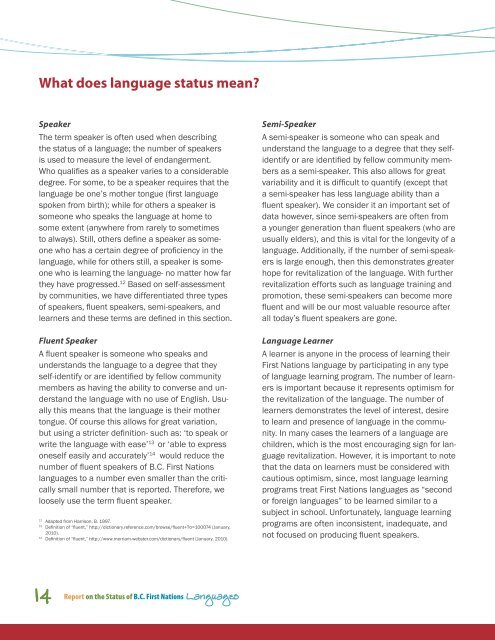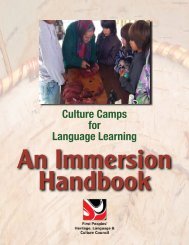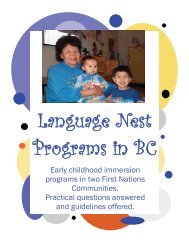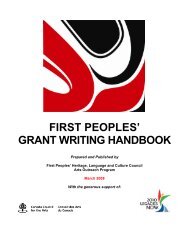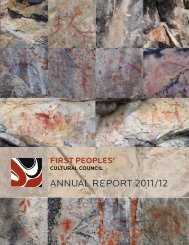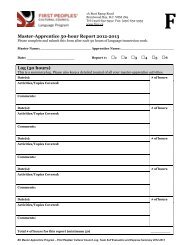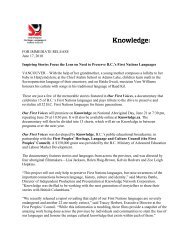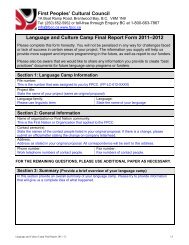What is the status of BC First nations languages? - First Peoples
What is the status of BC First nations languages? - First Peoples
What is the status of BC First nations languages? - First Peoples
You also want an ePaper? Increase the reach of your titles
YUMPU automatically turns print PDFs into web optimized ePapers that Google loves.
<strong>What</strong> does language <strong>status</strong> mean?SpeakerThe term speaker <strong>is</strong> <strong>of</strong>ten used when describing<strong>the</strong> <strong>status</strong> <strong>of</strong> a language; <strong>the</strong> number <strong>of</strong> speakers<strong>is</strong> used to measure <strong>the</strong> level <strong>of</strong> endangerment.Who qualifies as a speaker varies to a considerabledegree. For some, to be a speaker requires that <strong>the</strong>language be one’s mo<strong>the</strong>r tongue (first <strong>languages</strong>poken from birth); while for o<strong>the</strong>rs a speaker <strong>is</strong>someone who speaks <strong>the</strong> language at home tosome extent (anywhere from rarely to sometimesto always). Still, o<strong>the</strong>rs define a speaker as someonewho has a certain degree <strong>of</strong> pr<strong>of</strong>iciency in <strong>the</strong>language, while for o<strong>the</strong>rs still, a speaker <strong>is</strong> someonewho <strong>is</strong> learning <strong>the</strong> language- no matter how far<strong>the</strong>y have progressed. 12 Based on self-assessmentby communities, we have differentiated three types<strong>of</strong> speakers, fluent speakers, semi-speakers, andlearners and <strong>the</strong>se terms are defined in th<strong>is</strong> section.Fluent SpeakerA fluent speaker <strong>is</strong> someone who speaks andunderstands <strong>the</strong> language to a degree that <strong>the</strong>yself-identify or are identified by fellow communitymembers as having <strong>the</strong> ability to converse and understand<strong>the</strong> language with no use <strong>of</strong> Engl<strong>is</strong>h. Usuallyth<strong>is</strong> means that <strong>the</strong> language <strong>is</strong> <strong>the</strong>ir mo<strong>the</strong>rtongue. Of course th<strong>is</strong> allows for great variation,but using a stricter definition- such as: ‘to speak orwrite <strong>the</strong> language with ease’ 13 or ‘able to expressoneself easily and accurately’ 14 would reduce <strong>the</strong>number <strong>of</strong> fluent speakers <strong>of</strong> B.C. <strong>First</strong> Nations<strong>languages</strong> to a number even smaller than <strong>the</strong> criticallysmall number that <strong>is</strong> reported. Therefore, weloosely use <strong>the</strong> term fluent speaker.12Adapted from Harr<strong>is</strong>on, B. 1997.13Definition <strong>of</strong> “fluent,” http://dictionary.reference.com/browse/fluent+?o=100074 (January,2010).14Definition <strong>of</strong> “fluent,” http://www.merriam-webster.com/dictionary/fluent (January, 2010).Semi-SpeakerA semi-speaker <strong>is</strong> someone who can speak andunderstand <strong>the</strong> language to a degree that <strong>the</strong>y selfidentifyor are identified by fellow community membersas a semi-speaker. Th<strong>is</strong> also allows for greatvariability and it <strong>is</strong> difficult to quantify (except thata semi-speaker has less language ability than afluent speaker). We consider it an important set <strong>of</strong>data however, since semi-speakers are <strong>of</strong>ten froma younger generation than fluent speakers (who areusually elders), and th<strong>is</strong> <strong>is</strong> vital for <strong>the</strong> longevity <strong>of</strong> alanguage. Additionally, if <strong>the</strong> number <strong>of</strong> semi-speakers<strong>is</strong> large enough, <strong>the</strong>n th<strong>is</strong> demonstrates greaterhope for revitalization <strong>of</strong> <strong>the</strong> language. With fur<strong>the</strong>rrevitalization efforts such as language training andpromotion, <strong>the</strong>se semi-speakers can become morefluent and will be our most valuable resource afterall today’s fluent speakers are gone.Language LearnerA learner <strong>is</strong> anyone in <strong>the</strong> process <strong>of</strong> learning <strong>the</strong>ir<strong>First</strong> Nations language by participating in any type<strong>of</strong> language learning program. The number <strong>of</strong> learners<strong>is</strong> important because it represents optim<strong>is</strong>m for<strong>the</strong> revitalization <strong>of</strong> <strong>the</strong> language. The number <strong>of</strong>learners demonstrates <strong>the</strong> level <strong>of</strong> interest, desireto learn and presence <strong>of</strong> language in <strong>the</strong> community.In many cases <strong>the</strong> learners <strong>of</strong> a language arechildren, which <strong>is</strong> <strong>the</strong> most encouraging sign for languagerevitalization. However, it <strong>is</strong> important to notethat <strong>the</strong> data on learners must be considered withcautious optim<strong>is</strong>m, since, most language learningprograms treat <strong>First</strong> Nations <strong>languages</strong> as “secondor foreign <strong>languages</strong>” to be learned similar to asubject in school. Unfortunately, language learningprograms are <strong>of</strong>ten incons<strong>is</strong>tent, inadequate, andnot focused on producing fluent speakers.14Report on <strong>the</strong> Status <strong>of</strong> B.C. <strong>First</strong> Nations Languages


